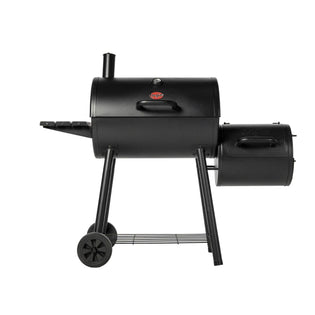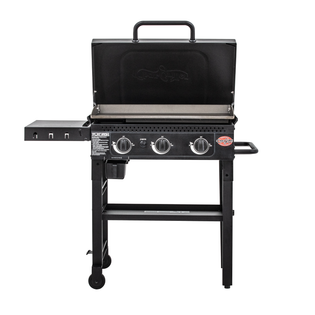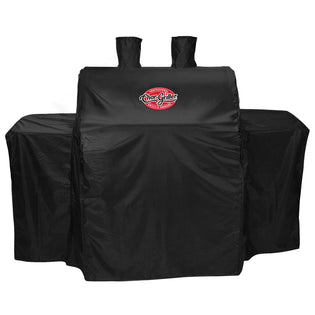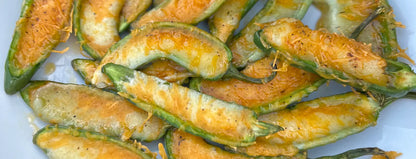What's more important? Time or Temperature. Our Ambassador John McLain of @grillin_in_the_atx answers that question!
The age-old argument…
I belong to a Facebook BBQ and Grilling group. I post a variety of pics: seafood, steak, ribs, chicken, and everything in between. Besides the usual requests for the recipe or what spices and rubs I used, I am often asked how long it took to grill or smoke it. My answer is always “until it was done”. This is a popular question posed to a number of my fellow BBQ aficionados and it’s always the same answer: it’s done when the meat reaches your desired internal temperature, whatever that is. I wasn’t even immune from this question from my wife! We had some real doozies about this, as ‘until it’s done’ was not an acceptable answer when guests were involved. Luckily, she has since come around.
How long to smoke brisket is probably the #1 BBQ question asked. The most common Google search answers say 90 minutes per pound or different variations of the same. The question grillers should be asking is: “at what temperature should you smoke a brisket?” and “at what temperature should you pull a brisket off the smoker?” The most famous brisket cooks will say smoke at anywhere from 225 to 275 degrees ambient temperature (I am of the 275 degree mindset), and pull your brisket anywhere from 195 to 205 degrees internal temp.
There are other things to consider: the weight of the brisket and the thickness of the fat cap. Is it Choice, Prime, Wagyu, or Grass Fed, because they vary wildly in marbling. How hot is your grill? What is the outside temperature? What kind of fuel are you using? Was the brisket room temperature or cold when you put it on the grill? Learning about how different cuts react to different variables is important, but at the end of the cook, the internal temperature is really all that matters, not time on the grill or smoker. Brisket is, by all accounts, the most challenging of all cooks. It is high risk – high reward, time consuming, and takes practice. The first brisket I ever smoked was pretty good. The 2nd and 3rd ones were terrible. It’s a stressful 10-12 hours every time I do it, which is a few times a year. And I learn something new every time I cook one.
For steak, temperature also rules over time. Many use the finger and thumb method to determine level of doneness but since finger and thumb sizes vary wildly, you can’t beat a quality thermometer to determine level of doneness. 120 to 125 is rare, and 130 to 135 is medium rare. I won’t become accessory to the crime of anything over medium rare. I have 2 sets of thermometers: a dual probe for checking thickest part of the meat and the ambient temperature of the grill at the same time, and my pocket probe (I call him “The Referee”) that I use to validate the accuracy of the meat probe. Investing in quality thermometers is a small price to pay, because you can always cook a steak more, but you can’t uncook it. Unless you’re a seasoned griller who has cooked thousands of briskets and ribs and can tell doneness by the feel of the meat, the thermometer is your friend.
I was cooking steaks with a friend a year or so ago who now owns his own craft beef company, has the farm, the certified Angus cattle, processing and delivery etc… He brought over a bunch of steaks one day and we sat in my backyard and grilled enough steak for 10 people. Fortunately for me, it was just the 2 of us. The reason we were doing this was comparing his 100% grass fed beef to grocery store Prime beef.
While we were grilling and drinking I found out he used to be a member of a competition BBQ team in his younger days. This was fascinating to me. While I have NO DESIRE to ever do that, the logistics are interesting to me. One of the things that stuck out to me was that he learned to never use a thermometer on brisket and ribs (both beef and pork). He said he did it all by feel. He said he could tell by the feel of a brisket or a rack of ribs when they were ready. While I would not risk this, he’s cooked literally thousands of briskets and thousands of racks of ribs. Practice makes perfect right? When it came to chicken, he said he still used a thermometer though just as a safety precaution. I asked him what the average backyard griller should do. He laughed and said DEFINITELY use a thermometer. Again, he referred back to the thousands of hunks of beef, pork and chicken he’d smoked and grilled and said that you average person shouldn’t risk it. Use a thermometer every time.
We talked about the many variations and styles of grills and smokers and debated on which style was best for what cuts of meat, the one thing we definitely agreed on is that regardless of how ‘dialed in’ you are with your grill, temperature rules all. I’ve cooked enough steak in my life where I can touch it and tell if it’s rare or medium rare or whatever level of doneness but I would NEVER do that with a brisket or a rack of pork ribs and certainly not a whole chicken or turkey.
So whether you prefer low and slow, hot and fast, direct or indirect heat, Kamado style or pellet, barrel style or vertical smoker, don’t worry about time. The most important thing is the internal temperature and not how long it takes. Without trying to sound like Neil deGrasse Tyson…time is human construct and therefore irrelevant. That statement is no truer anywhere than in the world of BBQ.
While I have a total of 5 grills/smokers, I primarily use two different grills. I have a Char-Griller Akorn (and Akorn Jr.) and a Char-Griller dual fuel of which I have added a side smoker box to the charcoal side so in essence it functions as a stick-burner. I’ve had the Akorn for 5+ years and I can do anything on it. The stick burner doesn’t get as much use but definitely holds larger cuts of meats better simply due to sheer size. They both have their advantages and disadvantages but it all boils down to a personal preference.

 Flat Iron® Portable 17-inch Gas Griddle
Flat Iron® Portable 17-inch Gas Griddle
 Flat Iron® Premium Gas Griddle
Flat Iron® Premium Gas Griddle
 Flat Iron® Gas Griddle with Lid
Flat Iron® Gas Griddle with Lid


 Sauced and No Sauce Spare Ribs
Sauced and No Sauce Spare Ribs
 Pulled Pork n' Bacon Cheesy Sliders
Pulled Pork n' Bacon Cheesy Sliders
 Smoked Pulled Leg of Lamb
Smoked Pulled Leg of Lamb




